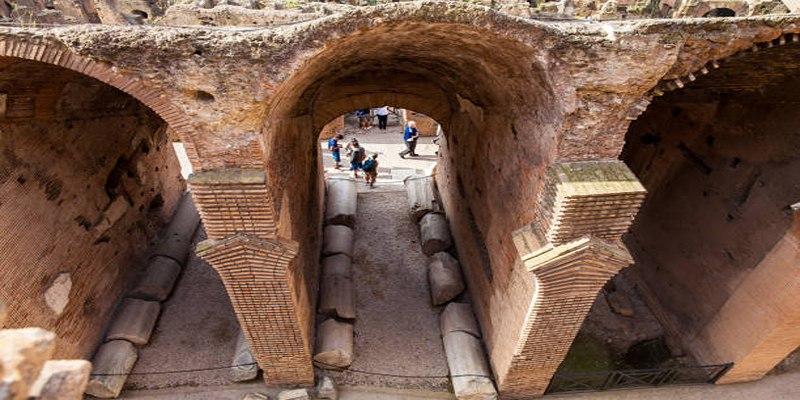The Colosseum, one of the most significant achievements of ancient engineering in Rome, is opening the hypogeum, an extensive network of tunnels under the arena, which has been entirely accessible to audiences after 2,000 years. Get lost in the place where gladiators, stagehands, and animals once prepared for grand spectacles. This offers exclusive access that sheds a fresh light on one of the most iconic landmarks in history.
A Labyrinth Beneath the Sand

Hypogeum is a Greek word used in the form of the hypo (under) and ge (earth). The backstage area of the ancient world was the hypogeum of the Colosseum, a complex space located two stories below, comprising corridors, elevators, and holding pen areas concealed beneath the wooden and sand-covered arena floor. This underground world was ordered by the Emperor Domitian, who was the younger brother of Emperor Titus, on the completion of the Colosseum. It was an essential improvement over the previous, simpler, and underground space, which became flooded during simulated naval wars (naumachiae).
This maze was the core of the activities of the Colosseum. Here, gladiators trained, and animals of all kinds, lions, tigers, bears, and even rhinos, taken in all over the Roman Empire, were confined in a cage and then hoisted into the arena. The sheer logistical involvement of what happened in the hypogeum is frightening. There was a darkness crowded, noisy, and chaotic, with the sound of raving animals, screaming stagehands, and squeaking machines.
What Was the Hypogeum Used For?
The primary role of the hypogeum was to ensure that the spectacles in the arena were as impressive and shocking as possible. You are thinking of a gladiator as he struggles to defend his life, when out of a trapdoor in the center of the arena, a lion snaps into view. It was this that was enabled by a clever system of elevators and hoists.
The Elevator System
Remains of up to 28 wooden elevators or pegmata have been found that were used to raise scenery, animals, and gladiators in the arena. Such elevators utilized capstans and conveyor wheels, operated by a team of enslaved people. These teams could haul the cumbersome platforms all the way up to the arena with a combination of pulling the ropes. Elements of dramatic entrances, sudden appearances, thrilled the Roman audience, which was made possible. The accuracy of their ability to lift these pieces during a live performance serves as a testament to the exceptional engineering experience of the Romans.
Holding Pens and Corridors
The hypogeum was also a maze of corridors and holding cells. Animals were kept in pens until it was their turn to enter the arena. Gladiators had their own waiting areas, where they could prepare mentally and physically for the battles ahead. There were also armories for weapons and rooms for stage machinery. The main corridors were designed to allow for the smooth flow of people and animals, ensuring that the games ran without a hitch. One of the main tunnels led directly to the Ludus Magnus, the largest gladiatorial school in Rome, allowing fighters to enter the Colosseum without being seen by the public.
The Restoration Project
For centuries, the hypogeum was buried under rubble and debris. With the decline of the Roman Empire, the Colosseum was abandoned, and its stone was used for quarrying. The hypogeum was sealed, and its existence was largely forgotten until archaeological excavations. Yes, it's the 19th century, to everybody.
The most recent revival, financed by the Italian luxury fashion brand Tod's, was a huge undertaking. Some archaeologists, architects, and engineers spent years painstakingly excavating the underground rooms and restoring them. The work focused on cleaning the centuries-old dirt and strengthening the old buildings, as well as constructing a new walkway that will enable tourists to learn more about the premises.
Another, and possibly the most important, stage in the restoration was the installation of a new retractable floor over part of the hypogeum. This new floor helps visitors imagine what the arena would have looked like during peak times and also allows for small cultural events to be arranged in the Bird's Colosseum again. It also shields the fragile underground systems against the elements.
What You Can See Today

It is an impressive experience to walk through the just-opened hypogeum. Going under the arena level, you can do away with the sound of modern Rome, and you become transported to a different period. The atmosphere is calm and prohibitively damp, and the masonry of the buildings is covered with the marks of centuries.
The new portion, a 160-meter (525-feet) walkway, takes you through the major halls within the hypogeum. You will get the views of the channels the elevators were used to work in and peer through the animal-pen shadows in the darkness. The proportions of the structure are gigantic, and one can effortlessly visualize the controlled madness that used to occupy these areas. It features informative displays and lighting that aid the viewer in appreciating the history of the hypogeum, including how the various mechanisms operated and what life was like for those who labored under the arena.
This access provides a more in-depth understanding of the Colosseum's purpose. It is no longer an object of sightseeing but instead an extremely advanced machine to provide entertainment. A personal visit to the hypogeum reveals the enormous amount of human creativity and skill that went into creating the games.
Final Thoughts
Access to the hypogeum of the Colosseum is a milestone in the discovery of its history. Tourists can now view the tunnels and have a further insight into the Roman culture, engineering, and society. This renovation is a crucial heritage and is more immersive. Any account of innovation, toil, and life lurks behind the significant facade; it would not be complete to travel to Rome without stepping down into the depths of this ancient arena.












